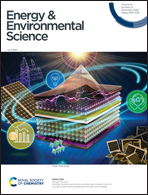Regulating the reorganization energy and crystal packing of small-molecule donors enables the high performance of binary all-small-molecule organic solar cells with a slow film growth rate†
Abstract
Difficulty in tuning the ideal phase morphology of interpenetrating network structures is the main reason for the relative inefficiency of all-small-molecule organic solar cells (ASM-OSCs). Achieving a desirable phase morphology is closely tied to both the molecular structure and film-formation process. Therefore, understanding the material's structural properties and film formation mechanism becomes crucial to improve the device performance. Herein, we have developed three small-molecule donors (T25, T26 and T27) through stepwise terminal-group and side-chain engineering. For the first time in the ASM-OSCs, we have analyzed the relationship between the material's structure, film formation mechanism and device performance by combining single crystal structure analysis and glow discharge optical emission spectroscopy (GD-OES) measurements. The results demonstrate that T27 exhibits a lower reorganization energy and a well-connected crystal packing, leading to a higher hole mobility compared to T25 and T26. Device performance results and morphological analysis indicate that the T27 : Y6-based ASM-OSCs yield enhanced efficiency compared to the T25- and T26-based ones. This enhancement can be attributed to the better charge generation and transport, suppressed charge recombination, more favorable molecular packing and slower film growth rate. These results not only provide insight into molecular designing, but also contribute to a deeper understanding of the film growth mechanism.



 Please wait while we load your content...
Please wait while we load your content...